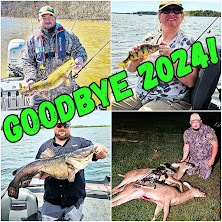Chasing River Cats in the Michigan Heat
Michigan will never make the list of top places to target catfish. We're completely out of the range for blue catfish, we're at the northern extreme for flatheads, and being so far north, channel cats, while abundant, are significantly smaller than their southern counterparts.
Growing up, and through most of my adult years, catfish were never a species of interest for our family. The waters we frequented just didn't have them, or if they did, we weren't aware of it. It wasn't until I was in my thirties that I even attempted to catch catfish intentionally.
I was invited to go fishing with my dad and uncle on a local lake. My uncle had been catching catfish there for several years so I was exited to give it a try. I had a vague understanding of the most common tactics for catfish, mainly live or cut bait on a slip sinker rig, just sitting on the bottom. I was more than a little surprised when I found out we were using bobbers. Not only were we using bobbers, we were drifting, rather than anchoring in one place, AND our baits were suspended about 4-8 feet above the bottom. I had never heard of such a thing. But the small channel cats that were so abundant in that lake were all over our bait.
I had only ever caught a few small bullhead prior to this, so the 12-14 inch average for the catfish was another welcome surprise. I even caught one that tipped the scale at five whole pounds! Listen, I know that's small potatoes, even for channel catfish, but on the light gear we were using, it was a heck of a fight. That was all it took to turn me onto targeting these whiskered fish.
Since then, I have fished that same lake a few times and did fairly well, although eventually the homeowners killed off all the weeds in the lake, and carp took over. You were lucky to catch a 6 inch cat or a tiny pale bluegill the last time I was there.
In the following years, I have traveled to South Carolina and Missouri specifically for fishing. The Santee Cooper, in South Carolina, introduced me to blue cats, and at a size I had never experienced for anything other than lake trout. Lake of the Ozarks in Missouri found me on the water with a little bit more knowledge and a keen desire to hook into more of these "big" fish.
Using tactics gleaned from countless YouTube videos, I managed to land a fair amount of eater sized blue cats. My primary tactic was drifting with Santee Rigs and using chicken breast as bait. It was a blast!
Since then, I have put a lot more effort into specifically targeting catfish near where I live. Michigan's Grand River has extremely high numbers of channel catfish and is known to contain some dandy flatheads, too.
Summer days are my primary time for targeting cats. Higher temperatures and lower water levels on the river concentrate fish into smaller areas that afford some relief from the heat. Holes that are just a few feet deeper than surrounding areas are much more likely to hold fish, especially if there is over head cover like tree branches. Holes that contain fallen timber, combined with overhead cover are the places I focus on first. Sloughs around bridge supports and similar structure are excellent secondary areas to target.
Once I've located an area I want to fish, I will set up about 10 yards upstream. I use both cut bait and live bait with about equal success. Bluegill, white perch, and sucker all are great choices. For live bait, I use a three way rig with about a 12-15 inch leader. For cut bait, I use either a Carolina style slip sinker rig or a Kentucky rig, which is similar to a drop shot setup. I prefer live bait that is about four or five inches long, and cut bait I generally do in one to three inch chunks depending on if I'm after chanels or flathead. If I'm after channel cats, I'll give each spot about 15 minutes or so before moving on. With flatheads I usually wait at least thirty minutes.
In Michigan, a medium spinning rod with a 3000 series reel and 30 lb monofiliment is more than sufficient for nearly any cat you hook into. If you plan on targeting the true giants (30 lbs and up in Michigan), a medium heavy rod with a 4000-5000 series real and 60 lb line might be more appropriate. Whatever gear you're using, make sure your leaders are lighter than your main line. You're going to get snagged fairly frequently if you want to get your bait where the fish are, and having a lighter leader means you aren't leaving nearly as much line in the water if you break off.
As daylight begins to fade into dusk, both species will leave whatever cover they are in and begin cruising in search of prey. Areas like patches of river grass, rock piles, and backwaters with weed cover are great areas to focus on as night takes over.
Michigan cats are a blast to catch and you're missing out if you're not targeting them. You can check out our first Michigan catfish video here to see what it's all about. We'll see you outdoors!





Comments
Post a Comment